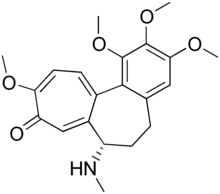| Revision as of 11:56, 4 April 2011 editLouisajb (talk | contribs)Extended confirmed users4,402 edits added the data from COLCEMID PAGE← Previous edit | Revision as of 12:06, 4 April 2011 edit undoCheMoBot (talk | contribs)Bots141,565 edits Updating {{drugbox}} (no changed fields - added verified revid - updated 'KEGG_Ref') per Chem/Drugbox validation (report errors or [[user talk:CheMoBotNext edit → | ||
| Line 1: | Line 1: | ||
| {{Drugbox | {{Drugbox | ||
| | verifiedrevid = |
| verifiedrevid = 414414817 | ||
| | IUPAC_name = (''S'')-1,2,3,10-Tetramethoxy-7-methylamino-6,7-dihydro-5''H''-benzoheptalen-9-one | | IUPAC_name = (''S'')-1,2,3,10-Tetramethoxy-7-methylamino-6,7-dihydro-5''H''-benzoheptalen-9-one | ||
| | image = Demecolcine.png | | image = Demecolcine.png | ||
Revision as of 12:06, 4 April 2011
Pharmaceutical compound | |
| Clinical data | |
|---|---|
| ATC code | |
| Identifiers | |
IUPAC name
| |
| CAS Number | |
| PubChem CID | |
| ChemSpider | |
| UNII | |
| ChEMBL | |
| CompTox Dashboard (EPA) | |
| ECHA InfoCard | 100.006.832 |
| Chemical and physical data | |
| Formula | C21H25NO5 |
| Molar mass | 371.43 g/mol g·mol |
| 3D model (JSmol) | |
SMILES
| |
InChI
| |
| (verify) | |
Demecolcine, also known as colcemid, is a drug used in chemotherapy.It is closely related to the natural alkaloid colchicine with the replacement of the acetyl group on the amino moiety with methyl, but it is less toxic. It depolymerises microtubules and limits microtubule formation (inactivates spindle fibre formation), thus arresting cells in metaphase and allowing cell harvest and karyotyping to be performed.
During cell division Demecolcine inhibits mitosis at metaphase by inhibiting spindle formation. Medically Demecolcine has been used to improve the results of cancer radiotherapy by synchronising tumour cells at metaphase, the radiosensitive stage of the cell cycle.
In animal cloning procedures Demecolcine makes an ovum eject its nucleus, creating space for insertion of a new nucleus.
Mechanism of Action
Demecolcine is a microtubule-depolymerizing drug like vinblastine. It acts by two distinct mechanisms. At very low concentration it binds to microtubule plus end to suppress microtubule dynamics. Recent study has found at higher concentration colcemid can promote microtubule detachment from microtubule organizing center. Detached microtubules with unprotected minus end depolymerizes with time. Cytotoxicity of the cells seems to correlate better with microtubule detachment. Lower concentration affects microtubule dynamics and cell migration.
References
- Brit med J., 1965, 1, 495 – 496
- Reprod Nutr Dev. 2006 Mar-Apr;46(2):219-26
- Jordan, Mary Ann; Wilson, Leslie (2004). "Microtubules as a target for anticancer drugs". Nature reviews. Cancer. 4 (4): 253–65. doi:10.1038/nrc1317. PMID 15057285.
- ^ Yang, Hailing; Ganguly, Anutosh; Cabral, Fernando (2010). "Inhibition of cell migration and cell division correlate with distinct effects of microtubule inhibiting drugs". The Journal of biological chemistry. 285 (42): 32242–50. doi:10.1074/jbc.M110.160820. PMC 2952225. PMID 20696757.
{{cite journal}}: CS1 maint: unflagged free DOI (link)
This antineoplastic or immunomodulatory drug article is a stub. You can help Misplaced Pages by expanding it. |